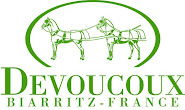A. My older sister and I went to summer camp in California. The school horses from Flintridge would spend the winter at the riding club and the summer at camp. We followed the horses. We lucked out; we were pointed in the right direction and had the right instruction. Jimmy Williams was the main trainer and mentor of mine and produced numerous trainers on West and East coast: Mary Marsha Poe, Anne Kursinski, Robert Ridland, Franny Starmavol. He was the man to be with and we were lucky enough to have the experience of being trained by him.

photo courtesy of Susie Hutshison
Q. You were clearly driven--becoming a professional at 18 with wins under your belt like winning the Junior Hunter division at the National Horse Show at 12. Where did that come from?
A. I pretty much knew this was the direction I would go at 16. I lived on the riding club property for 18 years and trained with Jimmy and stayed with him at the riding club past his passing away. It’s the combination a having the right trainer, having the right horses, and having the right parental support. I was also lucky enough to have the talent. I was the kind of kid that rode every horse that came through the gate. I’d teach at 6:00am until 7:00pm with the addition of riding a ton of horses. We’d have 11 top shows we’d do- we weren’t on the road week in week out like we are today. Jimmy was so open and he himself was exposed to different disciplines: dressage, saddle horses, you name it. He influenced us to be open mined. When I was a kid those different disciplines were at the horse shows together. I’ve done some reining and cutting: minimal but love it.
Center: Susie Hutchison; right: Jennie Brannigan
photo courtesy of Jennie Brannigan

Q. What about the event world?
A. The event world is fascinating. They all tell me it’s scary to ride to the showjumping jumps, but there’s no way I’d go riding to those solid jumps. That’s more scary! We help each other. I ask them what keeps them from feeling confident showjumping and give them more confidence. The lack of knowledge causes fear. If you have knowledge of what you’re doing and can pursue it and execute it then you’re no longer fearful. Without the right horse no matter how good you are you’ll never be at the top. It takes the two. You are only as good as you are mounted. The good event horses sometimes aren’t the most careful showjumpers. It’s a wonderful sport. But it’s a very difficult one in that you need to be the best at all three disciplines. That’s what’s so good about it. Going back to Jennie, she worked for me for a year-such a talent and so much energy. She was like a sponge. But she also had a lot of natural talent, she observed a lot and rode anything and everything in that barn. If you want it badly enough…I’ve watched enough kids and junior riders that I never thought would be professional but got there. You can have a horse with a lot of heart and rise. I would take that horse over one with a lot of talent but not enough will to put out that extra drive. To me it’s more about the heart and the try.
Q. You’ve won a lot of Grand Prix on a lot of horses including Red Baron, Bugs Bunny, and Cantano. Do any stand out to you?
A. Samsung Woodstock, he belonged to the Korean company Samsung. He’s buried in my backyard. I rode him at the World Equestrian Games in the Haugue. We went to four World Cup finals, he won me four automobiles, and we were 4th in Sweden at the World Cup. He was a fantastic horse. He came from Paul Shockumeiler, one of the biggest horse dealers in Germany.
Susie with Samsung Woodstock, the 'bridle-less horse'
at the World Equestrian Games

photo courtesy of Susie Hutshison
He’s got a lot of character. When we got him he didn’t want you in the stall, he tried to kick, he bucked after the jumps. He was kinds of a brat. We got him well schooled and he went in a bridle without headstall, just a ring around mouth. He showed all over world. People called him the bridle-less horse. We could ride him without a bridle. People were amazed. Had been sold at auction in England. A lot of the top British riders hated him and we bought him for Samsung and he turned out to be a horse that took me all over the world. There wasn’t a course that I walked that I didn’t think we could jump successfully. I think people are lucky to ever have one horse like that in a lifetime. I was lucky enough to have quite a lot of nice horses. America 1; Bugs Bunny was great but didn’t stay sound; Cantato is coming along. He’s green but hasn’t been able to prove what he’ll be. We started the world cup qualifiers and he should be in his prime in the next two years.

photo courtesy of Susie Hutchison
Q. Obviously the world sees you as one of the top showjumpers in the world. How do you see yourself?
A. I see myself as having been a really lucky person to have been exposed to the people I’ve had the luck of being around trainer-wise and the horses in my life that I’ve had.
Part II of Susie's interview is coming soon. Check back for part II!

























